As a cat owner, understanding your feline friend’s emotions and fears is essential for their well-being. One common fear that cats may experience is claustrophobia, a fear of confined spaces. Recognizing the signs of cat claustrophobia and implementing strategies to manage and overcome it can help create a more comfortable environment for your beloved pet.
Key Takeaways:
- Cats can experience claustrophobia, a fear of confined spaces.
- Signs of cat claustrophobia include increased heart and respiratory rates, panting, trembling, and salivation.
- Managing and treating cat claustrophobia involves creating a calm environment, behavior modification techniques, and, in some cases, medication or supplements.
- Proper socialization and gradual introductions can help prevent or reduce claustrophobia in newly adopted cats.
- When traveling with a claustrophobic cat, using a spacious carrier, providing comfort, and minimizing stress are essential.
Signs of Cat Anxiety and Fear
Cats can exhibit various signs of anxiety and fear, which can indicate the presence of a deeper issue. Recognizing these signs is crucial in identifying and addressing cat anxiety effectively. Some common signs of cat anxiety include:
- Avoiding eye contact
- Shifting body or head away
- Partially dilated pupils
These mild signs may indicate a certain level of discomfort or unease in your cat. However, more pronounced signs can include:
- Increased respiratory rate
- Crouching and leaning away
- Fully dilated pupils
When a cat displays these moderate signs, it indicates a higher level of anxiety and fear. In severe cases, cats may freeze in place, exhibit aggressive behavior, and have fully dilated pupils. Recognizing and understanding these signs can help you take appropriate steps to manage and alleviate your cat’s anxiety.
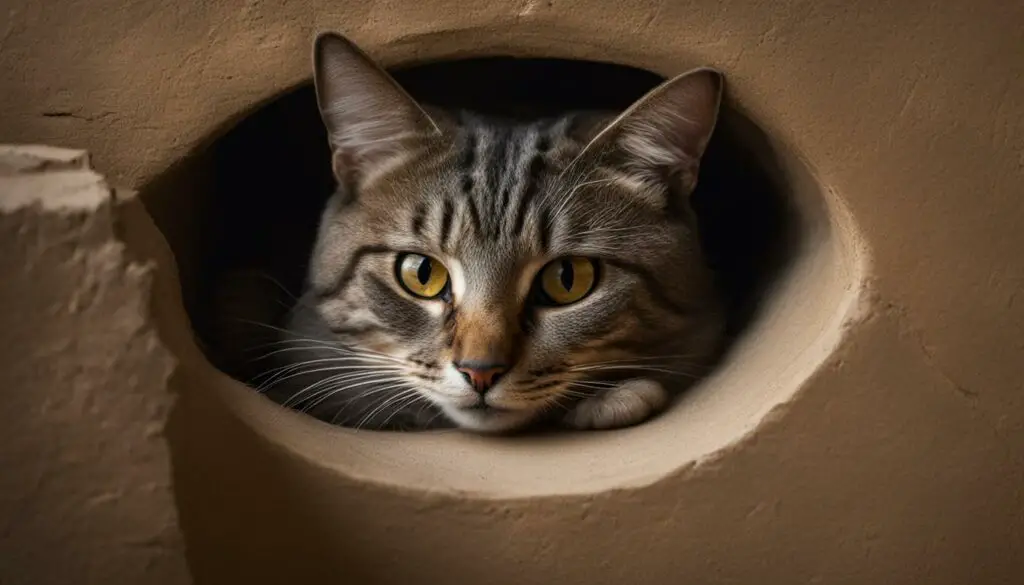
Causes of Cat Anxiety
Understanding the causes of cat anxiety is crucial in managing and addressing this common issue. There are various factors that can contribute to cat anxiety, including:
- Illness or physical pain: Cats experiencing discomfort or health issues may exhibit signs of anxiety.
- Traumatic experiences: Previous traumatic events, such as abuse or accidents, can lead to anxiety in cats.
- Improper socialization: Cats that have not been properly socialized during their early development stages may be more prone to anxiety.
- Separation anxiety: Cats that have difficulty being separated from their owners or familiar environments can experience anxiety.
Each cat is unique, and the causes of anxiety can vary. It is important to recognize and address the underlying causes to effectively manage and treat cat anxiety.
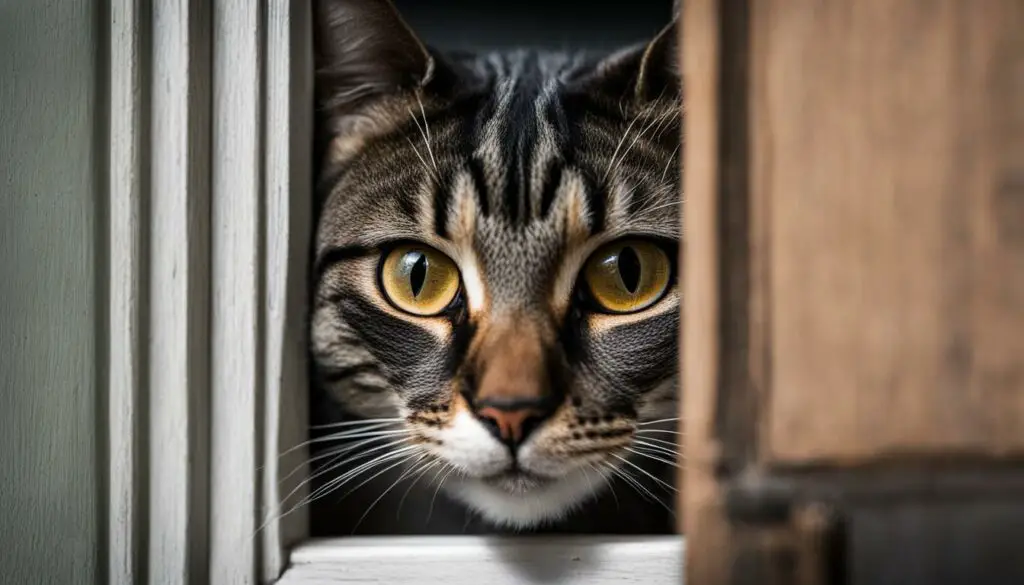
Understanding the causes of cat anxiety is crucial in managing and addressing this common issue.
How Vets Determine the Cause of Cat Anxiety
When it comes to determining the cause of cat anxiety, veterinarians employ a comprehensive approach that involves physical examinations, diagnostic tests, and careful observation of the cat’s behavior. The goal is to identify any underlying medical conditions or triggers that may be contributing to the anxiety. By understanding the root cause, vets can develop an effective treatment plan to alleviate the cat’s anxiety and improve its overall well-being.
During the physical examination, vets will assess the cat’s overall health and look for any signs of illness or discomfort that may be causing or exacerbating its anxiety. They may also recommend additional diagnostic tests, such as blood tests and urine tests, to rule out any underlying medical conditions.
Additionally, vets rely on a thorough history provided by the cat’s owner to gain insights into the cat’s environment, past experiences, and potential triggers for anxiety. This information, combined with careful observation of the cat’s behavior, allows vets to make a more accurate diagnosis and develop an individualized treatment plan.
Overall, the process of determining the cause of cat anxiety requires a holistic approach that considers both the physical and psychological factors affecting the cat. By working closely with a veterinarian, cat owners can gain a better understanding of their pet’s anxiety and find the most effective strategies to help their furry friend lead a happier and more relaxed life.

Table: Diagnostic Steps for Determining the Cause of Cat Anxiety
| Step | Description |
|---|---|
| Physical Examination | Thorough examination to assess overall health and identify any signs of illness or discomfort that may contribute to anxiety. |
| Diagnostic Tests | Additional tests, such as blood and urine tests, to rule out underlying medical conditions. |
| History and Observation | Gathering information from the cat owner and observing the cat’s behavior to gain insights into its environment, past experiences, and triggers for anxiety. |
Treating Cat Anxiety
When it comes to treating cat anxiety, there are various options available to help manage and alleviate their stress and fears. One approach is environmental management, which involves creating a calm and stress-free environment for the cat. This can be achieved by providing them with a safe space to retreat to, such as a cozy hiding spot or a designated area with their favorite toys and bedding. Additionally, using pheromone sprays or diffusers that mimic natural feline pheromones can help promote a sense of security and relaxation for the cat.
Behavior modification techniques can also be employed to change the cat’s response to anxiety-inducing stimuli. This may involve gradually exposing the cat to their triggers in a controlled and positive manner, helping them to develop new and more relaxed associations. Positive reinforcement, such as treats or praise, can be used to reward calm behavior and encourage a more positive outlook.
In some cases, medication or supplements may be necessary to help manage cat anxiety. These should only be prescribed and administered under the guidance of a veterinarian. Medications such as anti-anxiety medications or antidepressants may be recommended to help alleviate the cat’s anxiety and improve their overall well-being.
| Treatment Option | Description |
|---|---|
| Environmental management | Creating a calm and stress-free environment for the cat, providing them with a safe space |
| Behavior modification techniques | Changing the cat’s response to anxiety-inducing stimuli through gradual exposure and positive reinforcement |
| Medication or supplements | Prescribed under veterinary guidance to help manage cat anxiety |
It’s important to note that every cat is unique, and what works for one may not work for another. It may take some trial and error to find the most effective treatment plan for your cat. Consulting with a veterinarian who specializes in behavior or anxiety-related issues can provide valuable insights and guidance in developing a personalized approach to treating your cat’s anxiety.
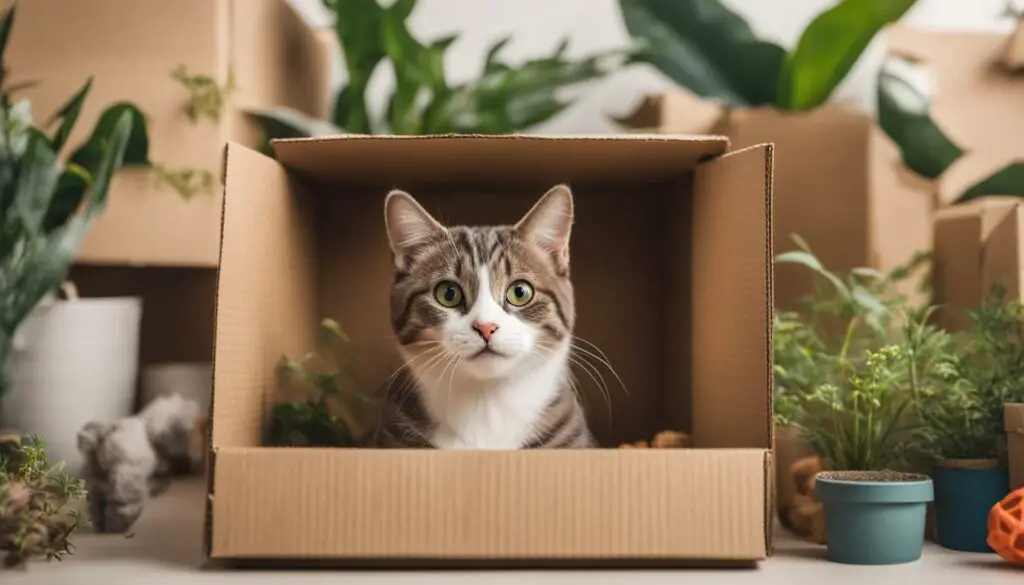
Managing Cat Anxiety
In addition to treatment options, managing cat anxiety involves incorporating strategies into everyday routines to help minimize stress and promote a sense of calm. Establishing a predictable daily routine can provide a sense of security for cats, as they thrive on consistency and familiar patterns. Creating a comfortable and enriched environment with plenty of toys, scratching posts, and cozy spots can help alleviate anxiety. Regular interactive play sessions can also help redirect their energy and provide mental stimulation, reducing anxiety levels. Finally, providing positive reinforcement for calm behavior and avoiding punishment or negative reinforcement is crucial in managing cat anxiety effectively.
Managing Cat Anxiety
Managing cat anxiety is essential for ensuring the well-being and comfort of your feline companion. By implementing a few simple tips and techniques, you can help reduce your cat’s anxiety and create a calmer environment for them.
Creating a Safe and Secure Environment
One of the most important aspects of managing cat anxiety is providing a safe and secure environment for your cat. This can include providing hiding places such as cat condos or shelves, where they can retreat to when they feel overwhelmed or anxious. Additionally, you can use pheromone sprays or diffusers, which release calming scents that can help reduce anxiety levels in cats.
Establishing a Routine
Cats thrive on routine, so establishing a consistent daily routine can help reduce anxiety in your cat. This includes feeding them at the same time each day, providing regular play and exercise sessions, and maintaining a consistent sleep schedule. By adhering to a routine, your cat will have a sense of predictability and stability, which can help alleviate anxiety.
Using Positive Reinforcement
Positive reinforcement is an effective way to manage cat anxiety. Rewarding your cat with treats, praise, or play whenever they exhibit calm and relaxed behavior can help reinforce positive associations and reduce anxiety over time. It’s important to be patient and consistent with this approach, as it may take time for your cat to adapt to the desired behavior.
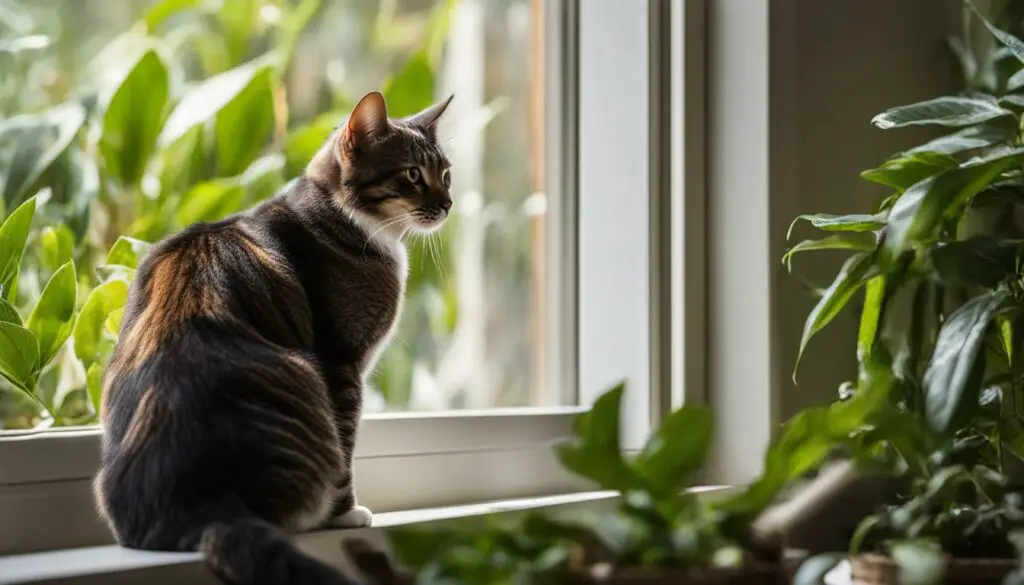
Providing Mental Stimulation
Mental stimulation is crucial for keeping your cat’s mind engaged and reducing anxiety. Provide interactive toys, puzzle feeders, or scratching posts to help keep their minds occupied and prevent boredom. Engaging in interactive play sessions with your cat can also help strengthen the bond between you and provide a positive outlet for their energy.
Conclusion
Managing cat anxiety requires time, patience, and understanding. By creating a safe environment, establishing a routine, using positive reinforcement, and providing mental stimulation, you can help reduce your cat’s anxiety and improve their overall well-being. Remember, every cat is unique, so it may take some trial and error to find the most effective management techniques for your furry friend.
Cat Anxiety Medicine
To help alleviate cat anxiety, veterinarians may prescribe medications that can help calm and manage the symptoms. These medications are specifically formulated for cats and can provide relief from anxiety-related behaviors. Medications for cat anxiety include antidepressants and anti-anxiety medications.
Antidepressants: These medications help regulate the neurotransmitters in the brain, promoting a more balanced emotional state for the cat. They can be effective in reducing anxiety and improving overall well-being. Some commonly prescribed antidepressants for cats include fluoxetine (Prozac) and amitriptyline (Elavil).
Anti-anxiety medications: These medications are designed to reduce anxiety symptoms and promote relaxation. They work by targeting the brain chemicals that are involved in the stress response. Commonly prescribed anti-anxiety medications for cats include benzodiazepines such as diazepam (Valium) and alprazolam (Xanax).
“Medications can be a helpful tool in managing cat anxiety. It’s important to work closely with a veterinarian to determine the appropriate medication and dosage for your cat’s specific needs.”
It’s important to note that medication should always be prescribed and monitored by a veterinarian. The dosage and duration of treatment will vary depending on the individual cat’s needs. In some cases, medication may be used in conjunction with other treatment methods, such as behavior modification techniques, to provide the best possible outcome for the cat’s anxiety management.
| Medication Type | Commonly Prescribed Medications |
|---|---|
| Antidepressants | Fluoxetine (Prozac), Amitriptyline (Elavil) |
| Anti-anxiety medications | Diazepam (Valium), Alprazolam (Xanax) |
Behavior Modification Techniques
When it comes to managing cat anxiety, behavior modification techniques play a crucial role in changing the cat’s response to anxiety-inducing stimuli. By employing these techniques, cat owners can help their cats overcome their fears and develop more positive associations with stressful situations.
Desensitization is a commonly used behavior modification technique for cat anxiety. It involves gradually exposing the cat to the feared stimulus in a controlled and positive manner. For example, if a cat is afraid of being in a carrier, the owner can start by leaving the carrier open in a familiar and comfortable environment. Over time, the cat can be encouraged to explore the carrier by placing treats or toys inside it. The goal is to gradually increase the cat’s comfort level with the carrier and reduce their anxiety.
Desensitization is a process that requires patience and consistency. It is important to go at the cat’s pace and not rush or force them into uncomfortable situations. By allowing the cat to approach and explore the feared stimulus on their own terms, they can gradually learn that there is no immediate threat, thus reducing their anxiety.
Counterconditioning is another behavior modification technique that can be used to change the cat’s emotional response to anxiety-inducing stimuli. It involves pairing the feared stimulus with a positive or enjoyable experience. For example, if a cat is afraid of car rides, the owner can associate car rides with treats or playtime. This helps the cat associate the previously feared stimulus with something positive, thereby changing their emotional response and reducing anxiety.
| Behavior Modification Techniques | Benefits |
|---|---|
| Desensitization | – Gradually exposes the cat to the feared stimulus – Reduces anxiety and fear |
| Counterconditioning | – Changes the cat’s emotional response to the stimulus – Helps in reducing anxiety and fear |
Working with a veterinarian or a veterinary behaviorist can provide guidance and support in implementing these behavior modification techniques effectively. They can help tailor the techniques to suit the individual needs of the cat and provide additional strategies to address specific anxiety-related behaviors. With patience, consistency, and the right approach, behavior modification techniques can be highly effective in helping cats overcome their anxiety and lead happier, more relaxed lives.
Summary:
- Behavior modification techniques aim to change the cat’s response to anxiety-inducing stimuli.
- Desensitization involves gradually exposing the cat to the feared stimulus in a controlled and positive manner.
- Counterconditioning involves pairing the feared stimulus with a positive or enjoyable experience to change the cat’s emotional response.
- Working with a veterinarian or veterinary behaviorist can provide guidance and support in implementing these techniques effectively.
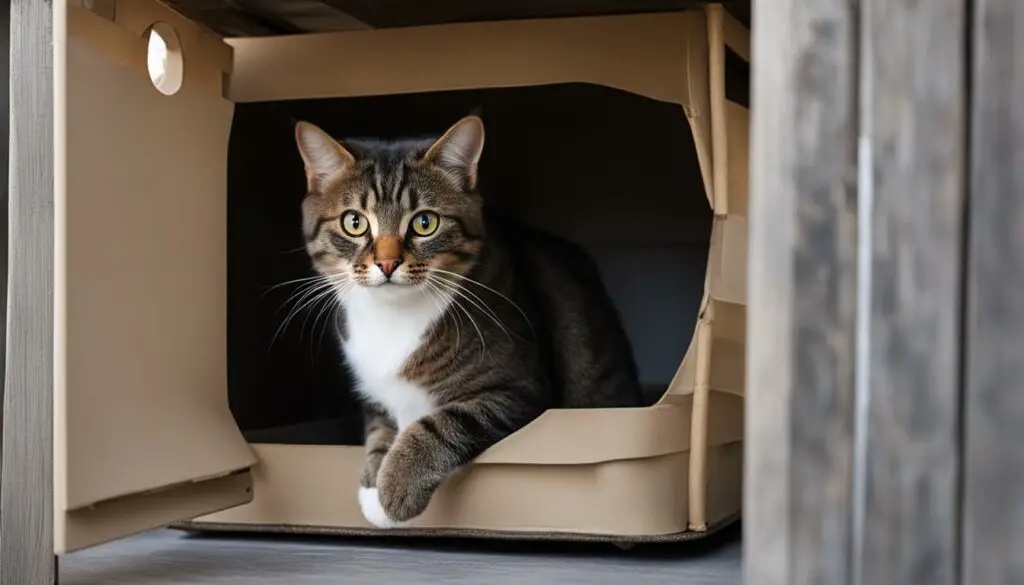
Preventing Cat Anxiety in Newly Adopted Cats
When bringing a newly adopted cat into your home, it’s important to take steps to prevent and reduce anxiety. Proper socialization plays a crucial role in helping cats adjust to their new surroundings and form positive associations. By gradually exposing them to new people, environments, and experiences, you can help build their confidence and reduce fear.
Creating a safe and secure environment is key to reducing anxiety in newly adopted cats. Provide them with hiding places where they can retreat to when they feel overwhelmed. This can be a cozy cat bed, a designated hiding spot, or even a covered crate. Having their own space gives them a sense of security and control.
| Ways to Reduce Anxiety in Newly Adopted Cats | Description |
|---|---|
| Slow and gradual introductions | Allow the cat to explore their new home at their own pace, without overwhelming them with too many new people or environments. |
| Positive reinforcement | Reward the cat with treats, praise, and playtime when they display calm and confident behavior. This helps them associate positive experiences with their new environment. |
| Providing vertical spaces | Cats feel safer when they have elevated perches or shelves where they can observe their surroundings from a higher vantage point. |
| Using pheromone sprays | Pheromone sprays, such as Feliway, can help create a calming atmosphere for a newly adopted cat. These sprays mimic the natural pheromones that cats use to mark their territory and feel secure. |
Remember, each cat is unique, and it may take time for them to fully adjust to their new home. Patience, understanding, and consistency are key when preventing cat anxiety in newly adopted cats.
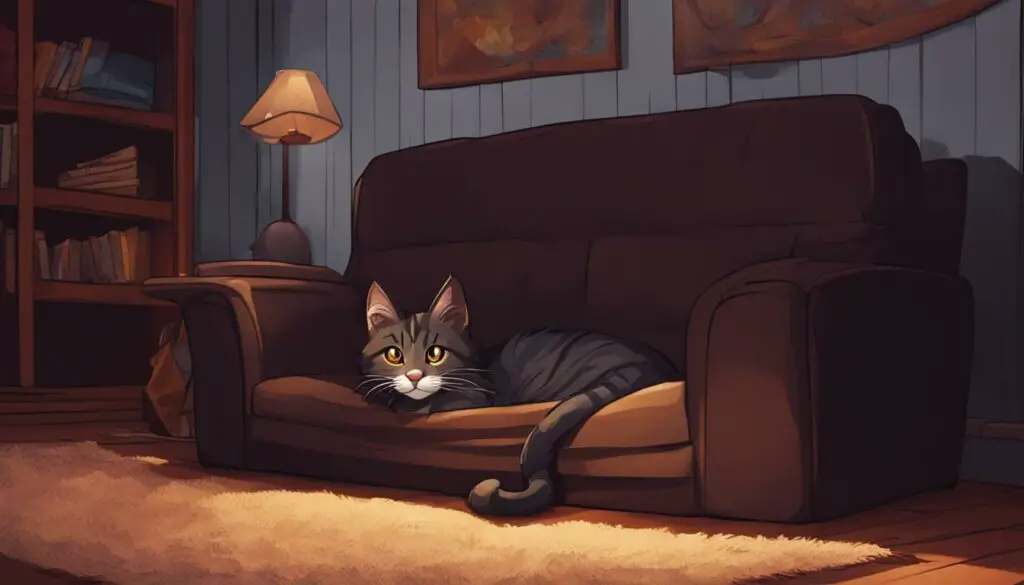
Tips for Traveling with a Claustrophobic Cat
Traveling can be a stressful experience for cats, especially those who are claustrophobic. As a cat owner, it’s important to take steps to minimize stress and create a comfortable environment for your feline friend during travel. Here are some tips to help you navigate the journey:
- Choose a spacious carrier: Opt for a carrier that provides plenty of room for your cat to move around comfortably. This will help prevent feelings of confinement and reduce anxiety.
- Provide familiar bedding: Place a soft and familiar bedding inside the carrier to make it more inviting for your cat. The scent of home can help alleviate their stress during the journey.
- Use calming products: Consider using calming sprays or collars that emit soothing pheromones. These can help create a calming environment and reduce anxiety for your cat.
- Avoid feeding before travel: To minimize the risk of accidents and discomfort, refrain from feeding your cat right before travel. This can help prevent nausea and reduce the chances of them getting sick in the carrier.
Remember, each cat is unique, and what works for one may not work for another. It’s important to observe your cat’s behavior and make adjustments accordingly. By taking the time to prepare and create a comfortable space for your cat, you can help minimize stress and ensure a smoother travel experience for both of you.
Tips for Traveling with a Claustrophobic Cat
Traveling with a cat who suffers from claustrophobia can be a challenge, but with the right approach, you can help minimize their stress and make the journey more comfortable for them. Here are a few additional tips to consider:
- Keep the carrier visible: To help your cat acclimate to the carrier, leave it out in a familiar and comfortable space at home. This will allow your cat to explore it at their own pace and get used to its presence.
- Positive reinforcement: Use treats, toys, and praise to create positive associations with the carrier. Reward your cat for approaching or entering the carrier, gradually closing the door, and remaining calm inside.
- Practice short trips: Before embarking on a long journey, take your cat on shorter trips in the carrier to help them get used to the experience. Start with brief outings and gradually increase the duration to build their confidence.
Remember, patience and understanding are key when traveling with a claustrophobic cat. Take the time to prepare them for the journey, provide a comfortable and stress-free environment, and monitor their behavior throughout. With a little planning and consideration, you can make the travel experience more enjoyable for your cat and ensure their well-being.
| Tips for Traveling with a Claustrophobic Cat |
|---|
| Choose a spacious carrier |
| Provide familiar bedding |
| Use calming products |
| Avoid feeding before travel |
| Keep the carrier visible |
| Positive reinforcement |
| Practice short trips |
Implementing these tips can help ensure a more comfortable and stress-free travel experience for both you and your cat. Remember to always prioritize their well-being and make adjustments as needed to accommodate their individual needs. Safe travels!
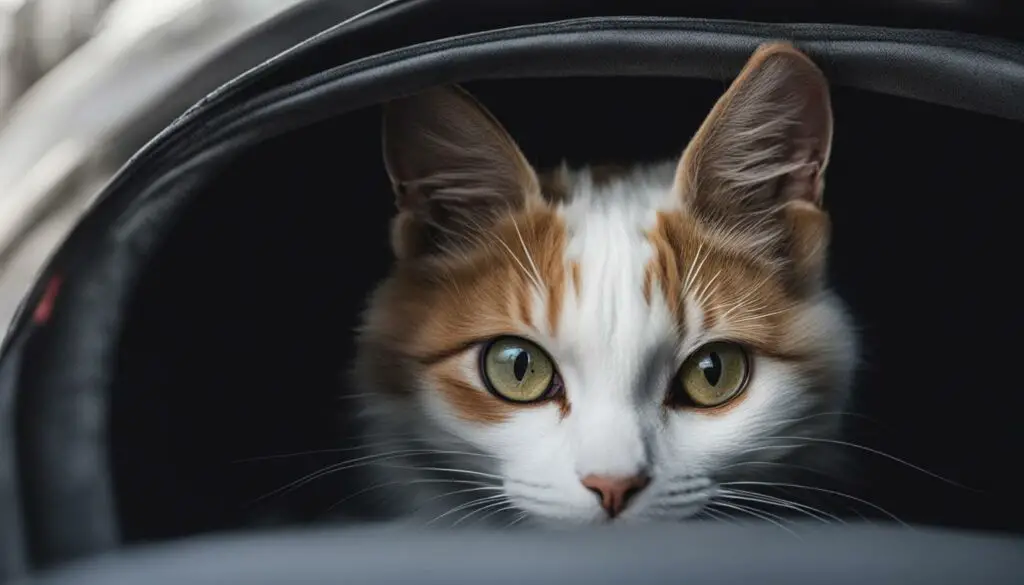
The Importance of Proper Cat Carrier
When it comes to traveling with your cat, choosing the right cat carrier is essential for their comfort and safety. A proper cat carrier provides a secure and enclosed space for your feline friend, ensuring their well-being throughout the journey.
One important factor to consider is the size of the carrier. It should be spacious enough for your cat to comfortably stand, turn around, and lie down. A cramped carrier can cause stress and discomfort, exacerbating any existing anxiety your cat may have. Additionally, the carrier should have proper ventilation to ensure adequate airflow during travel.
Comfort is another crucial aspect to prioritize when selecting a cat carrier. Look for carriers with soft bedding or padding to provide a cozy space for your cat. If your cat has a favorite blanket or toy, placing it inside the carrier can help create a familiar and comforting environment.
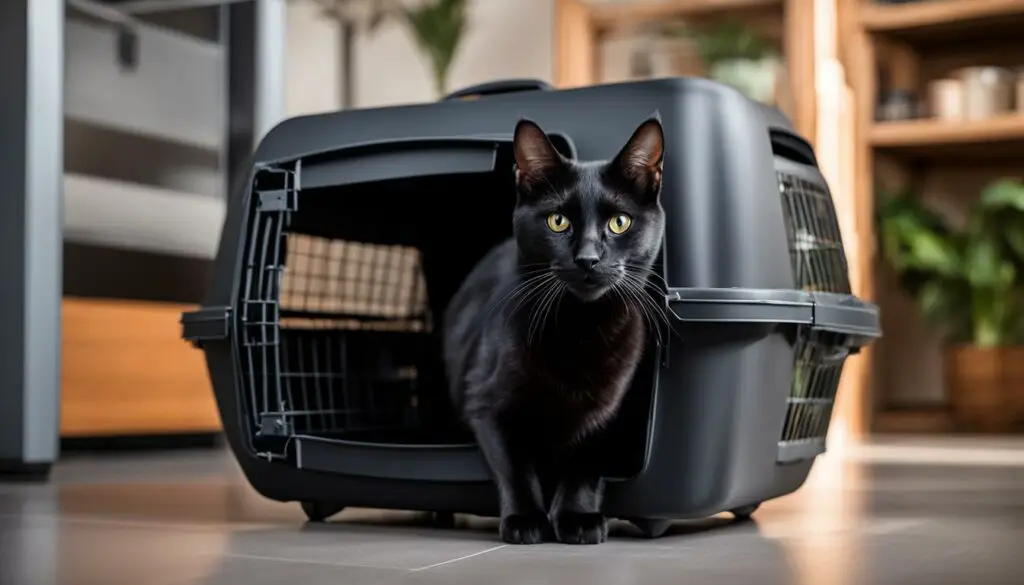
Table: Comparison of Cat Carrier Options
| Carrier Type | Pros | Cons |
|---|---|---|
| Hard-sided carrier | Durable and secure | May be heavier to carry |
| Soft-sided carrier | Lightweight and portable | Less protection in case of impact |
| Top-loading carrier | Easier to place and remove your cat | May be more difficult to clean |
| Expandable carrier | Offers more room for your cat | Can be bulkier to store |
“Choosing the right cat carrier is not just about convenience; it directly impacts your cat’s comfort and well-being during travel. It’s important to consider the carrier’s size, ventilation, and comfort features when making your selection.”
In addition to the carrier itself, it’s crucial to ensure that the carrier is cleaned regularly. A dirty carrier can harbor bacteria and unpleasant odors, which can add to your cat’s stress and discomfort. Regular cleaning and disinfecting will help keep the carrier fresh and inviting for your furry companion.
By prioritizing the importance of a proper cat carrier, you can create a more positive and enjoyable travel experience for both you and your cat. Taking the time to choose a carrier that provides adequate space, ventilation, and comfort will go a long way in reducing your cat’s anxiety and promoting their overall well-being.
Tips for Introducing the Cat to the Carrier
Introducing a cat to a carrier can be a daunting task, especially if they have a fear or anxiety associated with it. However, with patience and the right approach, it is possible to familiarize your cat with the carrier and make it a positive experience for them.
One effective way to introduce the cat to the carrier is to leave it out in a familiar and comfortable environment. Place soft bedding inside the carrier and leave it open so that the cat can explore it at their own pace. This allows them to associate the carrier with positive experiences and helps to alleviate any fear or anxiety they may have.
Using positive reinforcement techniques can also be beneficial in acclimating the cat to the carrier. Offer treats or play with their favorite toys near the carrier to create positive associations. Gradually move the treats and toys closer to the carrier, encouraging the cat to enter it willingly. This approach helps to build their confidence and familiarity with the carrier.
When the cat is comfortable entering the carrier, you can start gently closing the door for short periods of time. Gradually increase the duration while providing treats and praise to reward their calm behavior. This step-by-step process helps the cat feel more at ease and prepares them for longer periods of time in the carrier, such as during travel or vet visits.
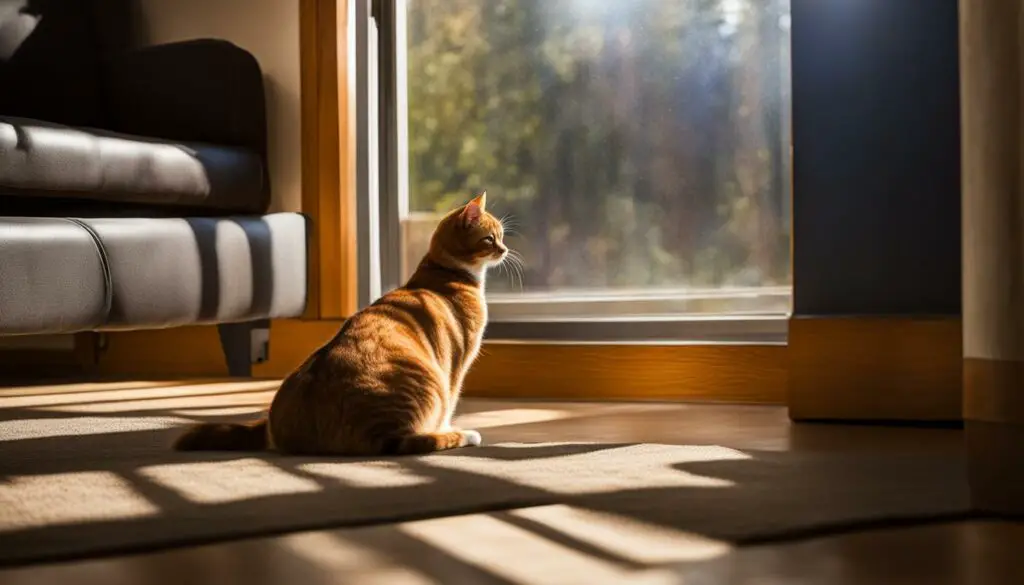
Remember to be patient and consistent throughout the process. Every cat is unique, and it may take some time for them to feel completely comfortable with the carrier. By taking the time to familiarize them with the carrier in a positive and gradual manner, you can help reduce their fear and anxiety, ensuring a smoother travel experience for both you and your feline companion.
Alternatives to Traveling with a Cat
When it comes to traveling with a cat, some pet owners may find it challenging or stressful for their feline companions. Fortunately, there are alternatives to traditional travel that can provide convenience and peace of mind for both the cat and the owner. Two popular alternatives are mobile veterinarians and in-home veterinary care services.
A mobile veterinarian brings veterinary care directly to the pet owner’s home, eliminating the need for the cat to be transported. This option is particularly beneficial for cats with high levels of anxiety or for pet owners who prefer a more convenient and stress-free option. Mobile veterinarians can provide a wide range of services, including routine check-ups, vaccinations, and even minor procedures.
In-home veterinary care services offer a similar level of convenience and comfort. With this option, a veterinarian will come to the pet owner’s home to provide veterinary care. This can be especially helpful for cats that become stressed or anxious in a traditional veterinary setting. In-home veterinary care services may include comprehensive examinations, diagnostic tests, and even specialized treatments.
Both mobile veterinarians and in-home veterinary care services prioritize the well-being and comfort of the cat, ensuring that they receive the necessary medical attention without the added stress of travel. These alternatives can provide a more personalized and relaxed experience for both the cat and the owner, making it easier to address any health concerns or needs.
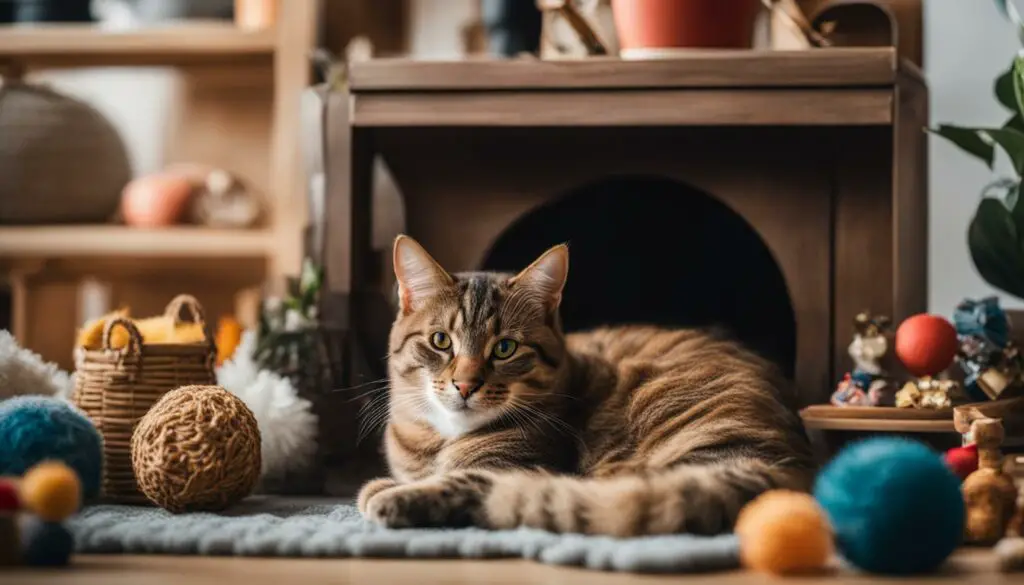
Mobile Veterinarians vs. In-home Veterinary Care
| Mobile Veterinarians | In-home Veterinary Care |
|---|---|
| Brings veterinary care to the pet owner’s home | Veterinarian comes to the pet owner’s home |
| Provides routine check-ups, vaccinations, and minor procedures | Offers comprehensive examinations, diagnostic tests, and specialized treatments |
| Ideal for cats with high anxiety levels or pet owners seeking convenience | Beneficial for cats that become stressed in traditional veterinary settings |
| Reduces the need for travel and minimizes stress for the cat | Creates a personalized and relaxed experience for both the cat and the owner |
Overall, considering alternatives to traveling with a cat, such as mobile veterinarians or in-home veterinary care services, can provide a more comfortable and less stressful experience for both the cat and the owner. These options prioritize the well-being of the cat while ensuring that necessary veterinary care is accessible and convenient. By choosing these alternatives, pet owners can alleviate anxiety and make veterinary appointments a more positive and enjoyable experience.
Conclusion
In conclusion, understanding and addressing cat anxiety, including claustrophobia, is crucial for the well-being of our feline friends, particularly during travel. By recognizing the signs of cat anxiety and fear, such as increased heart rate, trembling, and salivation, we can take steps to manage and treat it effectively.
Creating a calm and stress-free environment, using behavior modification techniques, and considering medication or supplements can help alleviate cat anxiety. It’s important to work closely with a veterinarian to determine the underlying causes and develop an individualized treatment plan.
When traveling with a claustrophobic cat, providing a spacious carrier, using familiar bedding, and introducing the cat to the carrier gradually can significantly reduce stress. Additionally, considering alternatives to traveling, such as mobile veterinarians or in-home veterinary care, can offer a more convenient and stress-free option for our anxious feline companions.
By prioritizing the emotional well-being of our cats and implementing these strategies, we can help them overcome their fears and make travel a more positive experience for both them and us. Remember, a calm and confident cat is a happy cat!
FAQ
Can cats experience claustrophobia?
Yes, cats can experience claustrophobia, which is a fear of confined spaces. It can manifest as anxiety and have various physical and behavioral signs.
What are the signs of cat anxiety and fear?
Signs of cat anxiety can include increased heart and respiratory rates, panting, trembling, salivation, avoidance of eye contact, crouching, aggression, and dilated pupils.
What causes cat anxiety?
Cat anxiety can be caused by factors such as illness or physical pain, traumatic experiences, improper socialization, and separation anxiety.
How do veterinarians determine the cause of cat anxiety?
Veterinarians conduct thorough physical exams, may recommend additional tests, and gather information about the cat’s behavior and history to identify the underlying causes of cat anxiety.
How is cat anxiety treated?
Treatment often involves a combination of environmental management, behavior modification techniques, and medication or supplements prescribed by a veterinarian.
How can cat anxiety be managed?
Managing cat anxiety involves creating a calm environment, providing hiding places, using pheromone sprays, establishing a routine, and offering positive reinforcement.
Are there medications for cat anxiety?
Yes, veterinarians may prescribe antidepressants or anti-anxiety medications to help alleviate cat anxiety. These medications should be closely monitored and supervised.
What are behavior modification techniques for cat anxiety?
Behavior modification techniques include desensitization and counterconditioning, which aim to change the cat’s response to anxiety-inducing stimuli with the guidance of a veterinarian or veterinary behaviorist.
How can cat anxiety be prevented in newly adopted cats?
Proper socialization, exposure to positive experiences, and choosing cats with friendly temperaments can help prevent or reduce anxiety in newly adopted cats.
How can I minimize stress when traveling with a claustrophobic cat?
Using a spacious carrier, providing familiar bedding, using calming products, and avoiding feeding before travel can help minimize stress during travel.
What should I consider when choosing a cat carrier?
It is important to choose a carrier that is spacious, well-ventilated, and comfortable for the cat. Regular cleaning and making it a familiar space can also help reduce anxiety.
How can I introduce the cat to the carrier?
Gradual introduction, leaving the carrier out in a comfortable environment, using positive reinforcement, and gradually closing the carrier door can help the cat develop a positive association with the carrier.
Are there alternatives to traveling with a cat?
Yes, alternatives such as mobile veterinarians or in-home veterinary care services can provide convenient and stress-free options for cats with high levels of anxiety or for pet owners who prefer it.








